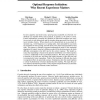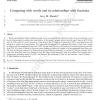6549 search results - page 32 / 1310 » Parsimonious additive models |
NIPS
2008
13 years 10 months ago
2008
In most cognitive and motor tasks, speed-accuracy tradeoffs are observed: Individuals can respond slowly and accurately, or quickly yet be prone to errors. Control mechanisms gove...
CSDA
2006
13 years 8 months ago
2006
The mixmod (mixture modeling) program fits mixture models to a given data set for the purposes of density estimation, clustering or discriminant analysis. A large variety of algor...
IPPS
2007
IEEE
14 years 3 months ago
2007
IEEE
Due to fundamental physical limitations and power constraints, we are witnessing a radical change in commodity microprocessor architectures to multicore designs. Continued perform...
ISCI
2007
13 years 8 months ago
2007
ct 9 Words mean different things to different people, and so are uncertain. We, therefore, need a fuzzy set model for a word 10 that has the potential to capture their uncertaint...
ISBI
2007
IEEE
14 years 3 months ago
2007
IEEE
In this work we investigate the feasibility and effectiveness of unsupervised tissue clustering and classification algorithms for DTI data. Tissue clustering and classification ...


